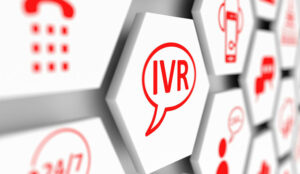We share some best practices for creating on-hold messages that will reflect your brand and better the customer experience.
Five Examples of IVR Messages
In this article, we have suggested a few examples for on-hold messages. For your convenience, we have repeated them below, with a couple of fresh examples thrown in as well.
- “At the moment our average wait time is X minutes. If you wish to wait that’s great, but – if not – press 1 and we’ll give you a call back.”
- “You can now track your delivery online. Just go to www.website.com with the tracking number that was included in your confirmation email.”
- “We now have a discount on our product that is great for X. Speak to an advisor to find out more.”
- “If you’re happy to share your feedback with us at the end of the call, by answering one simple question, press 1 now and help us improve this experience in the future.”
- “We have recently opened a live chat service so you can talk directly to an advisor online instead of phoning in. Just visit www.website.com to try out this new service for yourself.”
How to write IVR Messages
1. Set Expectations in the Customer Greeting
Before the customer enters the call queue, it is good to have a system that tells them of the average wait time, according to Steve Hindley the Creative Director at iNarratorOnHold.
This initial IVR message will go along the lines of: “At the moment our average wait time is X minutes. If you wish to wait that’s great, but – if not – press 1 and we’ll give you a call-back and hold your place in the queue.”

Steve Hindley
Explaining how a call-back works, Steve says: “The caller would simply be asked to record their name and number. Then they can put the phone down and get on with their lives, knowing that their place in the queue has been reserved.”
Once the caller reaches the front of the queue, the advisor will call the customer back, so they don’t have to listen to “that” hold music and can instead get on with other tasks in the meantime.
2. Present Greeting IVR Messages in Order of Importance
Call queues will vary in length, so the customer is unlikely to hear every message that you create, which is why it’s critical that you order them in terms of importance.
Steve explains: “Due to your average hold time, you may find that 80% of people will hear the first message, 20% will hear the second and 10% the third, which will highlight the importance of how you order your on-hold messages.”
“The most relevant message should be front and centre, but the nature of that message may vary from one call queue to another, so that’s something that you must think about as well.”

The most relevant message should be front and centre, but the nature of that message may vary from one call queue to another.
Also, consider if each message is fit to be implemented across all call queues. While a message that highlights a promotional deal may be appropriate in certain queues, it will not be for a queue where the customer has indicated through the IVR that they would like to make a complaint.
3. Include a “Call to Action” in the IVR Messages
The idea of a call-to-action message is to give the customer a little bit of information and something they can act on, to boost your revenues and their satisfaction.
As Steve says: “Hold messages can be great to sow the seed of an idea in the customer’s mind. Think of this type of message as a mini-radio commercial, in the sense that you sell the idea and then ask people to take action on the back on it.”
An example of such a message would be: “We now have a discount on our product that is great for X. Speak to an advisor to find out more.”
Make sure you don’t write a call-to-action message that says ‘we’re good at this’ or ‘we’re great at that’ – your customers won’t care for these… Use information that will either inform them or entertain them.
Steve Hindley
But what about our earlier worry of making offers to unhappy customers? Well, there’s a way around it, as Steve explains: “The call to action doesn’t have to be a log-on to buy message, it could be log onto our website and enter your account number to receive a certain perk.”
“Just make sure you don’t write a call-to-action message that says ‘we’re good at this’ or ‘we’re great at that’ – your customers won’t care for these. This is because you are telling them what they already know. Use information that will either inform them or entertain them.”
4. Avoid Repeating the Same IVR Greeting
Don’t replay the same IVR greeting message every 20 seconds as that’s a sure-fire way to irritate the customer before they even have the chance to speak to an advisor. This is particularly the case where you have high call volumes.
Instead, Steve recommends to: “Look at the average hold time and make sure that you have enough messages to cover that period of time. So, if someone is on hold for an average of two minutes, you want to have at least three messages with a good gap of music in between each one.”
Look at the average hold time and make sure that you have enough messages to cover that period of time.
“There is a fine line between having the right number of messages and repeating the same message over and over again. It is a balancing act of how many messages you want to record, but also having enough to say in them as well.”
Some of the messages will be informational, some will be sales-focused and others may be more entertaining – all should serve a different purpose to better engage the customer.
5. Get the Right Music to Message Ratio
The general rule here is that for every two seconds of message, three seconds of music should come afterwards, with more music if the wait time exceeds five minutes.
As Steve says: “We would have a message that lasts for no more than 20 seconds and then a music interlude in between that lasts for 30 seconds, so it feels like there’s more music than message.”
“That’s the ratio that we aim for, but if there is an unexpected peak in demand for the contact centre that causes contact volumes to rise to a point where customers are waiting for five or ten minutes, increase the musical gap between each message.”

Have a message that lasts for no more than 20 seconds and then a music interlude in between that lasts for 30 seconds, so it feels like there’s more music than message.
Yet Steve also stresses that there is no hard-and-fast rule and says that it sometimes requires a bit of trial and error, as well as feedback from advisors, with whom customers will share their opinions.
6. Customise Voice and Language Style for Different Call Queues
Contact centres need to think about the tone of their voice and the type of language used in each message, to ensure that it’s ‘on-brand’. However, these elements don’t have to be consistent for every call queue.
Steve explains: “For a sales line you might want somebody who has more of an upbeat voice, to create a subtle ‘buzz’ around the product. But, for a support line, you would likely prefer the voice to be a little more relaxed, to try and calm the customer before they speak to an advisor.”
In terms of language, Steve also believes that, unless it goes against your brand’s identity, messages should be:
- Developed in spoken and not written language
- Written with active language to create a sense of immediacy
- Without clichés such as: “Your call is important to us”
To test that you have developed style of voice and language, Steve advises that you “create personas for your top three customer types, considering things like ‘what newspapers would they likely read?’ and run them through your system.”
By creating personas, you will get a sense of not just the functional experience for your customer, but the emotional experience as well, so you sense their emotional response to each message.
For more on using personas, read our article: 6 Ideas for Customer Journey Mapping
7. Alternate Male and Female Voices
According to Steve, his company are having a lot of success with alternating male and female voices, with one voice used for every “odd” message and the other for each “even” message.
Start with a female voice and then use a male voice because, if you can keep this pattern going, every message catches the customer’s attention with that voice change.
Steve says: “It is good to start with a female voice and then to use a male voice because, if you can keep this pattern going, every message catches the customer’s attention with that voice change.”
While it’s good to have a different gender of voice speaking, remember to ensure that they are both on-brand. Don’t use polar opposite styles as that will only serve to alienate the customer.
8. Record the IVR Script in a Professional Environment
For cost reasons, contact centres often choose to record their IVR messages themselves, but this could damage the customer experience.
Steve believes that “callers will recognise the difference between a professional voice over and something that has been recorded in the back office – which has an echo, background noise and so on.”
Alongside the quality of the recording comes the quality of the music that you are using, and Steve recommends that you avoid well-known songs to remove licensing struggles and, more importantly, reduce complaints.
Steve says: “You’ve got to take people’s personal preferences into consideration. If you go with a well-known band or artist, then you’re going to get a mixed reaction.”
You’ve got to take people’s personal preferences into consideration. If you go with a well-known band or artist, then you’re going to get a mixed reaction.
“Generally speaking, it is better to use custom-produced music or music from the library of a specialist provider, so you can choose from a number of different genres without the customer having a polarising opinion of the band or artist.”
For more on the topic of on-hold music, read our article: What Customers Really Think of Music on Hold
9. Include FAQs and Direct Customers to Other Channels
If you have a customer support line, using messages to answer FAQs is a really proactive thing to do that will enable you to reduce contact volumes, according to Steve.
An example of this could be a message such as: “You can now track your delivery online. Just go to www.website.com with the tracking number that was included in your confirmation email.”

If you can see why the majority of people are on hold and add the answer they’re looking for into the on-hold message, that may be the end of the call.
Steve adds: “If you can see why the majority of people are on hold and add the answer they’re looking for into the on-hold message, or at least direct them to a quicker way of finding the answer, that may be the end of the call. This saves resources and can improve satisfaction.”
“While this may add to your abandon rate, it is for a good reason and you can track that in real time, as many contact centres do. So, if there is a spike in real time when you implement the message, you can work out the difference between positive and negative abandons.”
10. Don’t Over-Apologise
Just as when advisors say sorry too often during a phone call, if you repeat an apology over and over again while the customer waits in the queue, you remove some of the authenticity.
We are setting the expectation up front, so only apologise when you go past that expectation, otherwise you’re over-apologising, which takes sincerity away from the sorry.
Steve says: “Contact centres can be too apologetic. Most customers will understand that they may have to queue for a short amount of time.”
“If someone is waiting for five minutes or more, then you probably do start saying sorry for that. But we are setting the expectation up front, so only apologise when you go past that expectation, otherwise you’re over-apologising, which takes sincerity away from the sorry.”
In Summary
The best on-hold IVR messages are on-brand, in terms of both voice and language, and customised to the different call queues.
Within these different call queues, messages should be ordered in terms of importance, as we try to avoid playing the same message over and over again.
It is good for these messages to offer call-backs, make important announcements and answer FAQs to increase the number of positive abandons and boost satisfaction with the service provided.
Also, as a final nice tip, it is good to alternate between a female and male voice for each message, so that you’re sparking the attention of the caller when make a useful announcement.
If you liked some of the advice that we shared in this article, here are a few more to try:
- How to Write an IVR Script – With an Example
- How to Design a Contact Centre for Impatient Customers
- Positive Customer Service Language for Positive Conversations
Author: Robyn Coppell
Published On: 27th Feb 2019 - Last modified: 12th Aug 2025
Read more about - Technology, Abandoned Calls, Call Handling, Hold-Music, IVR Solutions, Language, Steve Hindley




































